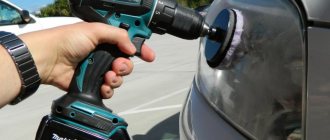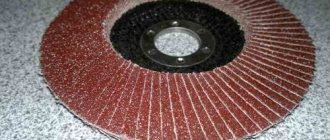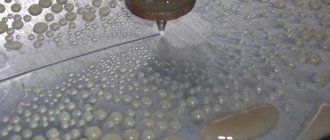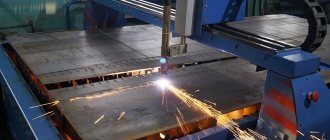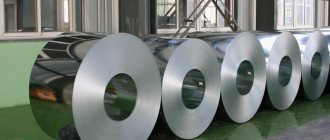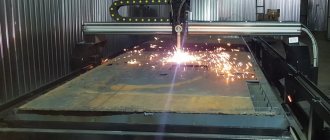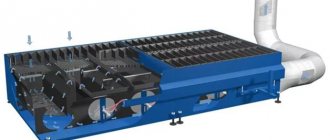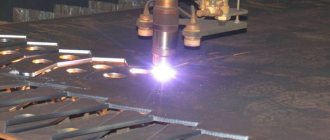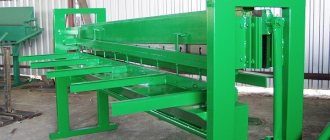Types of cutting wheels
Classification by purpose
- Metal discs. Scope of application: cutting reinforcement, profile pipes, steel angles, channels, sheet steel.
- Circles on wood. Also used for cutting plastic pipes, window profiles, plasterboard and MDF boards. Made from high-strength steel, the outer edge of the disc is equipped with sharp teeth.
- Cutting discs for stone. Designed to work with products made of sand-lime brick, paving slabs, stone structures, paving stones, asbestos-cement sheets.
Classification by production technology
Abrasive discs
The base of the metal disc consists of at least two layers of fiberglass mesh, on top of which a mass of abrasive materials is applied:
- corundum;
- silicon carbide;
- electrocorundum.
The technology for manufacturing cutting wheels for metal involves heat treatment, after which the product becomes resistant to destruction. The disc is baked in an oven at a temperature of +2000C.
Depending on the shape, abrasive consumable tools are divided into two types:
- flat disks;
- circles with a concave sleeve.
Diamond wheels
Area of application: cutting particularly durable materials:
- concrete,
- granite,
- marble,
- red brick,
- asphalt,
- stone
Made from steel. An abrasive mass containing diamond chips is applied to the end part of the circle. The width of the diamond-bearing layer varies from 1.5 to 3 mm.
In large-diameter circles intended for pass-through work, the width of the layer of diamond chips can reach 1-2 cm.
There are three types of diamond cutting discs on the market:
- Solid. Designed for wet cutting of materials, it is a solid disc with a continuous diamond edge.
- Segmented. Used for dry cutting. The cutting diamond edge is divided into separate segments.
- Turbo disc. The diamond-bearing edge is made in the shape of a wave. The presence of inclined grooves reduces the contact area with the working material, resulting in natural cooling. The universal wheel is used for wet and dry cutting.
Types of diamond blades for metal
Diamond blades vary in purpose, design, and manufacturing technology.
- If they are a round steel plate with a strip of diamond grains applied to its outer edge, they are called solid.
- If they have slots from the edge to the center for approximately 10–15% of the diameter, necessary for heat dissipation, they are called segmented. They can operate at high speeds.
- If an oblique notch is applied to the surface, then this is a turbo. They are more durable.
- A diamond cutting disc with slots and serrations is the most productive and is called turbo-segmented.
The marginal strip of grains is called the cutting edge. Diamond grains come in different sizes and are attached to metal in different ways. The size of diamonds determines work efficiency and working life. Large grains wash the metal being processed better, but wear out more quickly. Small ones work more accurately on metal, but their productivity is lower. But they have a higher working resource.
Diamond grains are attached to a steel plate in various ways: soldering, laser welding, and electroplating. The purpose of the tool also depends on the method of fastening. Discs with soldered grains are used in conjunction with water cooling. Galvanically bonded grains work well with soft materials. Diamond blades with welded grains are good for cutting hard metal alloys.
Diamonds are fixed in the working rim in a certain order. There are disks with a uniform distribution, when segments of the same length contain the same number of crystals.
But there are products in which diamonds are placed at a certain frequency (sandwich). They have greater productivity, exert less pressure on the tool, are better cooled and distribute forces more evenly.
Characteristics of cutting wheels
Bundle type
The strength, productivity and quality of the cut depends on the type of bond. In the production of discs, organic and inorganic binders are used. The first type includes vulcanite and bakelite, the second - ceramic.
Vulcanite binder is a mass of rubber and sulfur that has undergone heat treatment. Discs based on it are characterized by a dense structure and elasticity.
The strength of the vulcanite bonded wheel allows for operating cutting speeds of 50,60 and 80 m/s.
The basis of the bakelite binder is powdered and liquid phenol-formaldehyde resins with fillers. Cryolite, alabaster, and pyrite are used as fillers.
Abrasive wheels on a bakelite bond are characterized by high bending and compressive strength, but they are not resistant to the effects of alkaline cooling water (the alkali content in the liquid should not exceed 1.5%).
The operating speed of circular rotation is over 80 m/s.
The disadvantage of bakelite binder is its low heat resistance: when heated to 2000C, it becomes brittle, and when the temperature rises to 250-3000C, it burns out.
The starting materials for creating a ceramic bond are:
- fire-clay;
- talc;
- liquid glass;
- chalk;
- quartz;
- feldspar.
The ceramic binder increases the water resistance of the abrasive tool; it is characterized by high fire resistance and resistance to chemicals. Disadvantages include sensitivity to impact loads and low bending strength.
Outer and inner diameter of cutting wheels
The market offers cutting discs with outer diameters from 115 to 500 mm. The following are in demand in everyday life:
- diameter 115 mm – designed for small-sized grinders;
- diameters 125, 150 mm – used in angle grinders of medium power and size;
- diameters 180, 230 mm - intended for professional tools.
The diameter of the seat for household tools is most often 22 or 32 mm.
Grain
The characteristic displays the cutting ability of the cutting wheel. The fraction of the abrasive substance varies in the range from 100 to 2000 microns. The higher the grain size, the better the cutting quality.
But at the same time, large abrasive grains reduce the strength of the consumable tool.
Abrasive substance
The performance quality of cutting discs is influenced not only by the grain size, but also by the shape and characteristics of the abrasive substance.
The shape of electrocorundum particles is most suitable for cutting steel products; harder grains of silicon carbide are intended for working with non-metallic materials or alloys of non-ferrous metals.
An important parameter is the heat resistance of the abrasive. Corundum abrasives have the best heat resistance; the operating temperature range of the substance is from 1700 to 19000C.
Diamond abrasives and boron carbide are characterized by the lowest heat resistance - 700-8000C.
Thickness of cutting wheels
The thickness of household cutting discs ranges from 1-5 mm. It is rational to use thin wheels when working with low-power angle grinders.
The smaller the height of the disk, the easier and faster the cutting process occurs - due to the lower resistance of the material. Cutting with a thick wheel will require more effort.
Consumable tools with medium and small outer diameters can have any thickness, circles with large diameters can only have the maximum thickness.
Advantages
The main advantages of abrasive wheels:
- the porous structure ensures natural cooling of the consumable tool;
- the disc does not become dull during operation;
- affordable price;
- large selection of products.
Positive qualities of diamond cutting blades:
- high cutting precision;
- wear resistance;
- there is no strong burning smell;
- minimum number of sparks during operation.
Main advantages and disadvantages
Diamond cutting discs are a universal tool. They are suitable for cutting not only metal, but also other materials of increased hardness: brick, reinforced concrete, foam concrete and others. The advantages of this tool include:
- increased geometric cutting accuracy;
- flat surface;
- almost silent operation.
The diamond blade does not exert pressure on structures adjacent to the cutting surface and does not change the structure of the material during operation. At the same time, significantly less time is spent on completing the work than when using other tools. The diamond wheel operates in the absence of a flow of sparks, and, as a result, there is no burning smell.
The cost of work using diamond blades should be calculated for each specific job.
The disadvantages of such a device include its high cost, but the working life of a diamond cutting tool significantly exceeds (almost 70 times) the working life of abrasive discs performing the same work. Equipment downtime is reduced by reducing the frequency of tool replacement. When using active cooling, it is possible to increase rotation speed and productivity. Throughout its service life, the tool retains its geometric characteristics.
Flaws
The negative qualities of abrasive consumables are:
- formation of a sheaf of sparks during operation;
- the appearance of a strong characteristic odor when cutting;
- rapid wear.
Disadvantages of diamond wheels:
- expensive;
- low heat resistance.
How to choose cutting wheels
The main designations influencing the choice of product are:
- type of compatible equipment (hand tools, stationary equipment);
- best before date;
- abrasive grain size (the smaller the numerical value of the grain size, the larger the grain fraction);
- outer diameter of the circle and seat size;
- thickness of consumable tool;
- maximum number of revolutions (the parameter should not exceed the rotational speed of the power tool);
- operating speed (indicated as a numerical value or marked with a transverse color stripe: yellow indicates speed up to 63 m/s, red – up to 80 m/s, green – up to 100 m/s);
- type of ligament, presence of a reinforcing element;
- purpose of the tool (the type of working material is indicated in the form of a graphic image or color designation).
Color designation of the type of working material
For abrasive wheels:
- green color - stone;
- blue color – steel.
Marking of diamond blades:
- green color – granite;
- blue color – marble, concrete;
- yellow color – tiles, alabaster;
- orange color – brick;
- gray color – granite, ceramics, tiles.
Which ones are better
The ideal cutting wheel is:
- Bakelite bonded product with a reinforcing element.
- Type of abrasive: for ferrous metals - simple electrocorundum, for stainless steel products - white electrocorundum.
- The average thickness of a cutting disc for metal is 1.6-2 mm.
- The universal outer diameter for a metal circle for household use is 125 mm.
- For cutting steel structures, it is better to use discs with a fine fraction of abrasive particles.
Diamond cutting
- For dry cutting of structures made of concrete, granite, brick, the ideal consumable tool would be a segmented diamond disc with an outer diameter of 230 mm and a diamond-bearing layer width of 2.5-3 mm.
- To organize furrows for the purpose of further laying utilities, it is better to choose a segmented circle with a diamond-bearing layer of 3.5 mm and a diameter of 350 mm.
- For working with ceramic tiles and marble, a solid diamond-coated cutting wheel is suitable. This cutting method requires mandatory cooling with water.
- For cutting reinforced concrete structures, it is better to use a diamond turbo disc.
Wood cutting wheel
- The best consumable tools for cutting wooden products are carbide discs reinforced with soldering with a high content of tungsten or cobalt carbides.
- The typical thickness of a wood disc is 3.2 mm.
- The universal size of the outer diameter is 130-250 mm.
- The ideal number of teeth for a cross cut is 80-90 cutters, for a longitudinal cut - no more than 60 cutters.
- The optimal angle of inclination of the teeth: for longitudinal cutting - 15-200, for cross cutting - 5-150.
The optimal cutting speed is selected depending on the type of wood:
- for soft rocks – from 50 to 90 m/s;
- for hard rocks – from 50 to 80 m/s;
- joinery wood – 60-80 m/s;
- exotic breeds - 80-85 m/s.
Exploitation
Working with abrasive cutting equipment involves high rotation speeds and requires compliance with safety measures. Before starting work, read the safety precautions specified by the manufacturer.
- Minors and people in a state of intoxication are not allowed to work with cutting devices. The presence of children and animals is not allowed near the work site.
- Carry out cutting work away from flammable materials.
- Use cutting discs only for their intended purpose.
- Before starting the operation, inspect the disc; do not use consumable tools with signs of damage (chips, cracks).
- Do not use expired wheels.
- Follow the rules for storing consumable tools.
- When working with power tools, use personal protective equipment.
Operating rules:
- Before starting cutting work, securely secure the wheel in the power tool.
- Use a tool that has a protective casing that can withstand the impact of a wheel break and catch any splinters.
- When cutting metal, secure the metal structure on only one side; this will help prevent excessive heating and deformation of the material, and, as a result, jamming of the abrasive disc.
- When cutting, keep the wheel straight, applying only radial pressure.
- If intense sparking occurs, cutting work should be stopped for 10-15 seconds, after the specified time has elapsed, continue working at a lower cutting speed.
Installing a cutting wheel into an angle grinder:
- Unplug the power tool.
- Using the special button, lock the rotation shaft.
- Install the disk into the seat.
- Tighten the lock nut and secure with a wrench.
- Before starting cutting work, check the functionality of the disc for 1 minute.
Pros and cons of carbide wheels for metal
I would like to immediately note that carbide discs have quite a lot of advantages over abrasive discs, but the price of the equipment and the discs themselves hinders the popularity of their use. Let's get everything straight!
The advantages include:
- Cutting accuracy. In order to maintain precision when cutting metal workpieces, a carbide blade on a pendulum saw is one of the best options for working.
- Speed of work. You will be surprised at how fast a carbide blade cuts.
- Huge disk resource. On average, the disk life is 5000 cuts. Compared to abrasive, it is immortal.
- No harmful emissions. When working with abrasives, a cloud of small particles is formed in the work area, which negatively affects human health.
- The metal does not heat up. After you cut the workpiece, you can safely handle it; it will be cold. The main advantage is that the properties of the metal do not change without exposure to temperature.
There are also disadvantages:
- Price. The cost of a carbide disc is tens of times more than an abrasive one. At home, with rare use, such a disk will not pay for itself.
- Loss of metal. Since the disc is thicker than an abrasive one, it is worth considering that the cutting line will be thick.
- Afraid of rust. If you decide to saw metal with rust, remember that this will wear out the disc faster.
Concluding all of the above, we can say that carbide wheels are more professional consumables. They have fewer disadvantages than their competitors, but the price makes them inaccessible for home use.
Manufacturers of cutting wheels
Bosch
The company occupies a leading position in the market of power tools and related products. The range includes abrasive cutting discs for wood, metal and stone, diamond wheels and universal models.
The quality of the company's products meets international quality standards.
Dremel
American brand products are sold in more than 60 countries around the world. The company's product range includes not only high-quality power tools, but also a wide selection of attachments.
Dremel produces cutting wheels for cutting wood, plastic, and metal. Diamond-coated discs can handle concrete, ceramics, marble, and porcelain.
FIT
The Canadian company specializes in the production of tools for household and professional use. The product range includes a wide selection of cutting disc models for metal and stone for household power tools.
FUBAG
The main direction of the German company is the production of high-quality professional equipment for repair and construction work.
The brand's production bases are located in Germany and Switzerland, the company's operating experience is more than 40 years. The catalog offers the consumer high-quality diamond blades for wet and dry cutting.
Husqvarna
Consumable tools from a Swiss manufacturer are characterized by high performance and durability. The company's product range includes a large selection of cutting diamond blades, as well as abrasive products for cutting metal.
The disadvantage of the Husqvarna brand is its rather high cost.
Makita
The company offers a large range of high-quality abrasive discs and segmented diamond-coated wheels. In the catalog you can find both budget models and products belonging to the middle and high price categories.
Master
The company has been supplying construction equipment for 15 years. The product catalog includes consumable tools for cutting metal and wood.
MESSER
The company's catalog includes many models of consumable tools with a wide range of applications:
- segmented diamond blades for cutting concrete and asphalt;
- circles with a continuous edge for cutting ceramic products, marble, porcelain stoneware;
- carbide blades for cutting high carbon steel;
- turbo rims.
Metabo
The German brand specializes in the production of professional power tools and cutting equipment.
The range of consumable tools includes a wide variety of abrasive and diamond discs for angle grinders, as well as saw wheels for wood.
Diamond blade manufacturers
The following companies are deservedly popular among manufacturers:
- Bosch. German leader in the production of power tools and related materials.
- FIT. The Canadian company produces tools for professional and household use.
- Dremel American company producing high quality power tools.
- Husqvarna. A Swiss company that is known for its high performance and level of durability.
- MESSER. A Korean manufacturer that produces a wide range of attachments for grinders.
- Zubr. Russian company producing power tools and cutting equipment.
- Hitachi Power Tools, Luga Abrasiv Extra. Has excellent value for money.
Diamond cutting discs are an effective tool with high productivity and provide comfortable conditions when performing work. Do you have experience working with them? Be sure to share it in the comments to this article.
